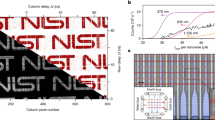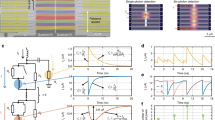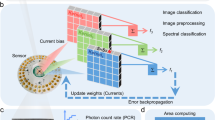Abstract
Coincidence measurement of photon pairs over a large spatial mode is crucial for revealing non-classical phenomena and advancing quantum information technologies, which usually require an increased number of time-resolved single-photon detectors. Superconducting nanowire single-photon detectors stand out for their superior detection metrics and on-chip integration feasibility. However, their array frameworks usually only enable the localization of one photon. Here we propose a two-terminal two-photon coincidence counter using superconducting nanowire transmission lines with customized delay-time series. Using combinatorial time logic and amplitude multiplexing, our device successfully resolves all 152 potential single- and two-photon events in a 16-pixel configuration. Compared with traditional superconducting single-photon detector arrays, the device also exhibits a higher dynamic range in classical low-photon-flux sampling by efficiently suppressing multi-photon distortion. This innovative array architecture showcases self-coincidence counting, scalability and straightforward readout, making it promising for large-scale on-chip coincidence measurement in quantum information processing, as well as high-dynamic-range single-photon imaging and sensing in low-light environments.
This is a preview of subscription content, access via your institution
Access options
Access Nature and 54 other Nature Portfolio journals
Get Nature+, our best-value online-access subscription
$32.99 / 30 days
cancel any time
Subscribe to this journal
Receive 12 print issues and online access
$259.00 per year
only $21.58 per issue
Buy this article
- Purchase on SpringerLink
- Instant access to full article PDF
Prices may be subject to local taxes which are calculated during checkout





Similar content being viewed by others
Data availability
The data that support the findings of this study are reported in the Article and its Supplementary Information. Source data are provided with this paper.
Code availability
The codes that support this study are available from the corresponding authors upon reasonable request.
References
Giustina, M. et al. Significant-loophole-free test of Bell’s theorem with entangled photons. Phys. Rev. Lett. 115, 250401 (2015).
Shalm, L. K. et al. Strong loophole-free test of local realism. Phys. Rev. Lett. 115, 250402 (2015).
Knill, E., Laflamme, R. & Milburn, G. J. A scheme for efficient quantum computation with linear optics. Nature 409, 46–52 (2001).
O’Brien, J. L. Optical quantum computing. Science 318, 1567–1570 (2007).
Kok, P. et al. Linear optical quantum computing with photonic qubits. Rev. Mod. Phys. 79, 135–174 (2007).
Wengerowsky, S., Joshi, S. K., Steinlechner, F., Hübel, H. & Ursin, R. An entanglement-based wavelength-multiplexed quantum communication network. Nature 564, 225–228 (2018).
Lemos, G. B. et al. Quantum imaging with undetected photons. Nature 512, 409–412 (2014).
Moreau, P.-A., Toninelli, E., Gregory, T. & Padgett, M. J. Imaging with quantum states of light. Nat. Rev. Phys. 1, 367–380 (2019).
Casacio, C. A. et al. Quantum-enhanced nonlinear microscopy. Nature 594, 201–206 (2021).
Peruzzo, A. et al. Quantum walks of correlated photons. Science 329, 1500–1503 (2010).
Sansoni, L. et al. Two-particle bosonic–fermionic quantum walk via integrated photonics. Phys. Rev. Lett. 108, 010502 (2012).
Crespi, A. et al. Anderson localization of entangled photons in an integrated quantum walk. Nat. Photon. 7, 322–328 (2013).
Defienne, H., Barbieri, M., Walmsley, I. A., Smith, B. J. & Gigan, S. Two-photon quantum walk in a multimode fiber. Sci. Adv. 2, e1501054 (2016).
Spring, J. B. et al. Boson sampling on a photonic chip. Science 339, 798–801 (2013).
Broome, M. A. et al. Photonic boson sampling in a tunable circuit. Science 339, 794–798 (2013).
Wang, J., Sciarrino, F., Laing, A. & Thompson, M. G. Integrated photonic quantum technologies. Nat. Photon. 14, 273–284 (2020).
Elshaari, A. W., Pernice, W., Srinivasan, K., Benson, O. & Zwiller, V. Hybrid integrated quantum photonic circuits. Nat. Photon. 14, 285–298 (2020).
Luo, W. et al. Recent progress in quantum photonic chips for quantum communication and internet. Light Sci. Appl. 12, 175 (2023).
Lita, A. E., Reddy, D. V., Verma, V. B., Mirin, R. P. & Nam, S. W. Development of superconducting single-photon and photon-number resolving detectors for quantum applications. J. Lightwave Technol. 40, 7578–7597 (2022).
Zadeh, I. E. et al. Superconducting nanowire single-photon detectors: a perspective on evolution, state-of-the-art, future developments, and applications. Appl. Phys. Lett. 118, 190502 (2021).
Ferrari, S., Schuck, C. & Pernice, W. Waveguide-integrated superconducting nanowire single-photon detectors. Nanophotonics 7, 1725–1758 (2018).
Häußler, M. et al. Scaling waveguide-integrated superconducting nanowire single-photon detector solutions to large numbers of independent optical channels. Rev. Sci. Instrum. 94, 013103 (2023).
Wollman, E. E. et al. Kilopixel array of superconducting nanowire single-photon detectors. Opt. Express 27, 35279–35289 (2019).
Allmaras, J. P. et al. Demonstration of a thermally coupled row–column SNSPD imaging array. Nano Lett. 20, 2163–2168 (2020).
Zhao, Q.-Y. et al. Single-photon imager based on a superconducting nanowire delay line. Nat. Photon. 11, 247–251 (2017).
Kong, L.-D. et al. Readout-efficient superconducting nanowire single-photon imager with orthogonal time–amplitude multiplexing by hotspot quantization. Nat. Photon. 17, 65–72 (2023).
Doerner, S. et al. Frequency-multiplexed bias and readout of a 16-pixel superconducting nanowire single-photon detector array. Appl. Phys. Lett. 111, 032603 (2017).
Oripov, B. G. et al. A superconducting nanowire single-photon camera with 400,000 pixels. Nature 622, 730–734 (2023).
He, G. et al. Simultaneous resolution of photon numbers and positions with series-connected superconducting nanowires. Appl. Phys. Lett. 120, 124001 (2022).
Zhu, D. et al. A scalable multi-photon coincidence detector based on superconducting nanowires. Nat. Nanotechnol. 13, 596–601 (2018).
Cheng, R. et al. A 100-pixel photon-number-resolving detector unveiling photon statistics. Nat. Photon. https://doi.org/10.1038/s41566-022-01119-3 (2022).
Qiang, X. et al. Large-scale silicon quantum photonics implementing arbitrary two-qubit processing. Nat. Photon. 12, 534–539 (2018).
Kong, L. et al. Noise-tolerant single-photon imaging with a superconducting nanowire camera. Opt. Lett. 45, 6732–6735 (2020).
Pernice, W. H. P. et al. High-speed and high-efficiency travelling wave single-photon detectors embedded in nanophotonic circuits. Nat.Commun. 3, 1325 (2012).
Zhu, D. et al. Resolving photon numbers using a superconducting nanowire with impedance-matching taper. Nano Lett. 20, 3858–3863 (2020).
Santavicca, D. F., Colangelo, M., Eagle, C. R., Warusawithana, M. P. & Berggren, K. K. 50 Ω transmission lines with extreme wavelength compression based on superconducting nanowires on high-permittivity substrates. Appl. Phys. Lett. 119, 252601 (2021).
Colangelo, M. et al. Impedance-matched differential superconducting nanowire detectors. Phys. Rev. Appl. 19, 044093 (2023).
Gaggero, A. et al. Amplitude-multiplexed readout of single-photon detectors based on superconducting nanowires. Optica 6, 823–828 (2019).
Kong, L. et al. Probabilistic energy-to-amplitude mapping in a tapered superconducting nanowire single-photon detector. Nano Lett. 22, 1587–1594 (2022).
Cahall, C. et al. Multi-photon detection using a conventional superconducting nanowire single-photon detector. Optica 4, 1534–1535 (2017).
Kong, L.-D. et al. Large-inductance superconducting microstrip photon detector enabling 10 photon-number resolution. Adv. Photonics 6, 016004 (2024).
Divochiy, A. et al. Superconducting nanowire photon-number-resolving detector at telecommunication wavelengths. Nat. Photon. 2, 302–306 (2008).
Acknowledgements
We thank the SIMIT-SNSPD group for technical assistance with the measurement instruments, and the Superconducting Electronics Facility (SELF) group for technical support with nanofabrication. This work was supported by the Innovation Program for Quantum Science and Technology (no. 2023ZD0300100) and the National Science Foundation of China (grant nos. 62301541, 61971408, 61827823 and 12033007). L.-D.K. acknowledges support from the Shanghai Sailing Program (grant no. 23YF1456200).
Author information
Authors and Affiliations
Contributions
L.-D.K. conceived the idea, designed the device and performed the measurements. T.-Z.Z., X.-Y.L. and J.-M.X. fabricated the device. X.Z. and T.-Z.Z. helped with the cryogenic set-up. H.L., Z.W. and X.-M.X. helped with the measurement. All the authors discussed the results. L.-D.K. and L.-X.Y. wrote the paper with input from all authors.
Corresponding authors
Ethics declarations
Competing interests
The authors declare no competing interests.
Peer review
Peer review information
Nature Photonics thanks Alexey Semenov and the other, anonymous, reviewer(s) for their contribution to the peer review of this work.
Additional information
Publisher’s note Springer Nature remains neutral with regard to jurisdictional claims in published maps and institutional affiliations.
Supplementary information
Supplementary Information
Supplementary Figs. 1–7 and Discussion.
Source data
Source Data Fig. 2
Statistical source data.
Source Data Fig. 3
Statistical source data.
Source Data Fig. 4
Statistical source data.
Source Data Fig. 5
Statistical source data.
Rights and permissions
Springer Nature or its licensor (e.g. a society or other partner) holds exclusive rights to this article under a publishing agreement with the author(s) or other rightsholder(s); author self-archiving of the accepted manuscript version of this article is solely governed by the terms of such publishing agreement and applicable law.
About this article
Cite this article
Kong, LD., Zhang, TZ., Liu, XY. et al. A superconducting nanowire two-photon coincidence counter with combinatorial time logic and amplitude multiplexing. Nat. Photon. 19, 407–414 (2025). https://doi.org/10.1038/s41566-024-01613-w
Received:
Accepted:
Published:
Issue date:
DOI: https://doi.org/10.1038/s41566-024-01613-w



